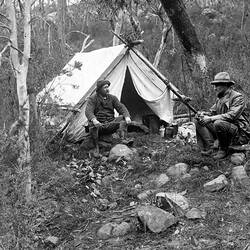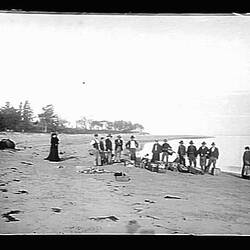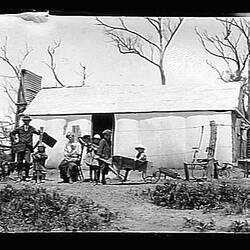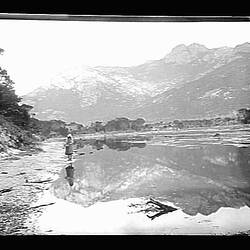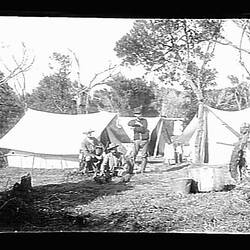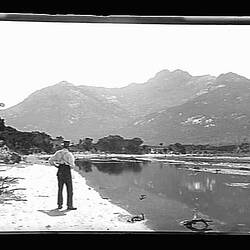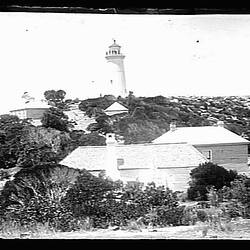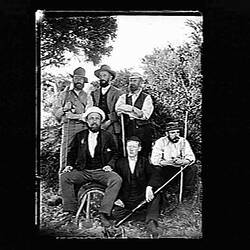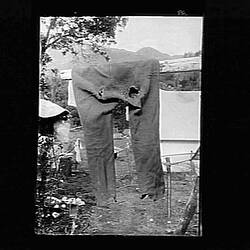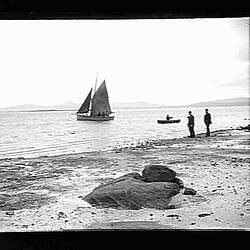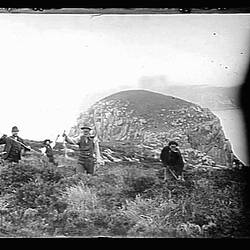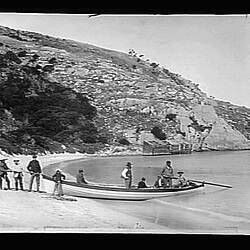Description of the Island
by. D. Le Souef
Transcribed from Victorian Naturalist Vol. 7, No. 9 Jan 7, 1891 pg. 121-122.
The Kent Group of Islands, which we have lately visited, are situated about 50 Miles S.E of Wilson's Promontory, and much nearer Australia than Tasmania. The group is composed of five islands, namely Deal, Dover, Erith, N.E and S.W Islands. Deal is the largest, and on it stands a lighthouse. This island is about 4 miles by 2 and is very hilly. The valleys are mostly covered with thick tussock grass, knee deep, and the hills are dense short scrub, consisting principally of Sheoak, Melaleuca, a small variety of the Eucalyptus, Pine (Callistris), Banksia, Acacias, and Ti-tree. All round the island, except in the coves, are bold granite cliffs, and lime stone is plentiful near the surface all over the island. There are several hills between 500 and 700 feet high, and the height of the land on which the lighthouse if built is over 900 ft. There are several small streams with slightly brackish water.
Erith and Dover Islands are separated from Deal Island by Murray Pass, which is about a mile wide and from 25 to 30 fathoms in depth, and through which a strong five-knot current runs. These two islands are joined by a narrow isthmus just above high water, Erith Island is fairly level in places and covered with grass, Goodenia, pig-face, scrub, and on one part some fair sized sheoaks. There is a good sheltered sandy beach opposite the pass. The highest point of the island is 568 ft.
Dover island seems to be altogether rock-bound, and is very hilly, with high cliffs on its west side, its highest point being 774 ft. It is covered in dense short scrub.
S.W Isle is a barren rock, 323 ft, about eight miles from the lighthouse, and close to the Judgement Rocks. The N.E Isle, on which the Mutton Bird rookery is situated, is about five acres in extent, and 345 ft high.
Although these islands are so close to Australia, their fauna is more closely allied to that of Tasmania, as, although the majority of birds are common to both, yet there are six or seven varieties belonging to Tasmania versus two belonging to Victoria. Of the reptiles the White-lipped Snake is found in both countries, as are the lizards, insects, and worms, except one lizard, which has not yet been identified, and which is probably not Victorian. The eel is the only freshwater fish found there, and it exists in both Tasmania and Victoria. With regard to plants, Baron von Mueller has kindly named those bought, and states that they all grow in Victoria as well as Tasmania. We should judge that the islands were joined to Tasmania after they had separated from the mainland, as so many Australian forms, both of fauna and flora, are absent, and yet the islands are within sight of Wilson's Promontory.
Report of Expedition to Kent Group
by. D. Le Souef
Transcribed from Vol. 7, No. 9 Jan 7, 1891 pp. 122 -131
The expedition which consisted of Messrs. D. Le Souef, A.J Campbell, T.C Campbell, C. Lane, Jos. Gabriel, G.A Keartland, and F.W Ford left Melbourne on Sat. 15th of Nov, in the S.S Despatch, starting from the Australian wharf at 1 o'clock. Early the following morning a call was made at Wilson's Promontory to land a passenger, and our course was then shaped passed Rodondo Rock, Devil's Tower, and Judgement Rock, instantaneous photographs were taken of each as we passed by them. On arriving near Kent Group we were struck with the boldness of the granite cliffs, but we soon steamed into Murray Pass, and into a very pretty little cove, with a nice sandy beach, bought by Mr. Brown, the light house-keeper, and his son in sight, and they came out in their boat to assist in landing us and our stores. When everything was safely on the beach we proceeded up a steep incline to the residence of the light-house keeper, and were welcomed with warm hospitality. We shortly after proceeded to Garden Cove, on the other side of the island, about two miles from the landing, and there chose our camping ground; and Mr. Brown kindly sent a dray and a splendid team of bullocks to the beach for our luggage, and bought it down to our camping ground, and long before nightfall we had everything snug.
Deal Island.
Our camp was about 300 yards from the beach, in the cove, and open grass land between, while just behind the three tents was a dense growth of Melaleuca, Sheoak, and other shrubs, which afforded shelter, while a stream with quantities of fine watercress, ran past the camp about twenty yards away. We had a beautiful view from our tent doors down the valley, with the blue water in the cove and the sea beyond, and on each side high hills covered with vegetation, and on their summits large granite boulders showing above the dark foliage.
Next day (Monday) we started work early- Three members went into the scrub to note the different birds; two others went dredging in the Murray Pass, and the rest to fish off the rocks in the cove not far from the camp. Those in the scrub were fortunate in finding four different varieties of eggs - namely, those of the Flame-breasted Robin, the Tasmanian Warbler (in which nest was also the egg of the Bronze Cuckoo) and the egg of the Narrow-billed Bronze Cuckoo, which was found in a newly finished nest of the Sombre-coloured Scrub Tit, in which the rightful owner had not yet laid. The scrub was very thick and difficult to get through. The members who were fishing caught Parrot Fish and Australian Rockling, and they reported that both kinds seemed plentiful; a large crayfish was also seen. Those who were dredging also were fairly successful in securing principally Polyzoa.
During the afternoon a visit was paid to the lighthouse, nearly four miles from our camp. It is built on a hill over 900 ft high, and one of the highest points on the island, and close to the steep cliffs that run down to the sea. The lighthouse itself itself is built of granite quarried hard by, and is a substantial structure. It was erected by more than 50 years ago, and has a flash light. The Tasmanian Government intended, I believe, replacing the old light at present with a new one. the light is visible 36 miles off. The two assistant lighthouse keepers, Messrs. Franklin and Hutchen, live in quarters close by, while the principle lighthouse keeper lives about a mile away, at the East Cove, in Murray Pass; there is telephone communication between the two places.
The day being fine, we had a splendid view, and clearly saw the highland of Wilson's Promontory, Rodondo Island, the Devil's Tower, Hogan Group, Curtis Group, and Judgement Rocks. The latter consists of three jagged looking rocks - one large and two small - they seem to lie in a line. The centre one is the smallest, and there is a level platform on one portion of it which the seals have chosen as one of their breeding grounds, and go there every year, in November, to have their young; a good many get killed by the half-caste sealers from Flinders Island; but it is only when the sea is very smooth that a landing can be effected, which is all in favour of the seals, otherwise the few there are would stand a good chance of being driven away from the islands of Bass Straits. The only other breeding ground near here is Craggy Island, situated between Kent Group and Flinders Island. From our high outlook, turning towards Tasmania, we could see a large portion of the coast line of Flinders Island, also the Two Sisters Islands, the Hummocks, and Craggy Island, and various small rocks, all showing the chain of islands and rocks extending from Wilson's Promontory, via Kent Group, Flinders and Barren Islands, to Tasmania, the only portions left of the land that once joined the two countries. Before leaving, photographs were taken of the lighthouse and adjacent cliffs, and on our way back to camp a pair of the Yellow-bellied Parrots and a Brush Bronzewing Pigeon were seen; and specimens were obtained of the Tasmanian Fantail, Sombre-coloured Scrub Tit, Tasmanian Warbler, and a hen Grey-tailed Thickhead, and also a few beetles, spiders and scorpions. A large White-lipped Snake was seen, but we were unable to capture it. when passing by the principal lighthouse-keeper's quarters, we were surprised to see two English sparrows. We could only account for their presence through their having been driven over by a strong N.W. wind from our Victorian coasts. As the evening closed in we could hear the penguins uttering their curious cry from a rookery situated on one side of Garden Cove, and they were noisy through the best part of the night. Early on Tuesday morning a visit was paid to the rookery, and we found the birds to be the Little Penguins. It was surprising to see how high up the steep cliffs many of the birds had their nests - in some cases fully 450 feet above the sea level. Many of the birds were sitting on their two white eggs, while others again had downy young ones in different stages of growth. The parent birds fought hard when interfered with, and could use their sharp beak and claws with effect, as those members who incautiously put their hands into their burrows can testify. The birds for the most part made their nests, which consisted of dry grass and weeds, in the cavities under or between the rocks. They breed all round the coasts of these islands, wherever they can secure a sufficient foothold to clamber up. In a few instances we found four eggs in one nest - two good and two addled ones - probably laid by different pairs of birds. At 8 o'clock we all started to visit Erith and Dover Islands, Mr. Brown having kindly promised to row us over. We arrived at East cove, and found the whaleboat ready, and soon rowed across Murray Pass, landing on a sheltered sandy beach on Erith Island, close to where the wreck of the s.s. Bullilies lies, with her two masts appearing above water, about 200 yards from the shore. Attempts have been made to raise her, large pontoons having been built for that purpose; but all efforts were apparently unavailing. One of the pontoons is still on the beach, but the other four that were made have been broken up and washed out to sea. The steamer had a cargo of 400 tons of coal, and was entering Murray Pass, when she struck a rock and sprung a leak. She was then brought in here to be beached, but sank before that could be accomplished. Erith Island Two of our members elected to remain in the boat for the purpose of dredging, and were successful in obtaining some specimens of Polyzoa. The rest of us ascended the sandy hillocks to explore the island. there were large numbers of penguins breeding here. The runs they had made on the beach to the places that were most easily ascended over the sand hillocks, to get inland, showed how numerous the birds must be. It looked as if a small flock of sheep had been driven up. There being no stones here under which to make their nests, they burrowed fairly deep holes instead, or laid under the thick tussocks of grass and pig-face, which latter plant was very abundant, and the masses of pink flower looked very beautiful in the bright sun. The first animal caught was a rabbit, which the dog got in a shallow hole. They appear very numerous on this island, where there are no half wild domestic cats to destroy them like there are on Deal Island. Shortly after the dog turned out a young opossum from under a tussock of grass, and it was secured unhurt, and it is now with another in our Zoological Gardens. We were told to beware of a vicious old billy goat which lives a lonely life on this island, but fortunately we did not come across him in our rambles. Two pairs of the Tasmanian Sooty Crow Shrike were seen, and a newly finished nest formed in a she oak tree, but not yet laid in. It is a curious fact that these birds seem to keep to this small island, and are seldom seen on the adjacent islands, which are larger. A pair of White-eyed Crows were also seen with their young, which had evidently only lately left their nests. The little White-eyes were numerous among the bushes, and a few of the White-fronted Scrub Tit were seen. A specimen of the Shining Flycatcher was also secured. We saw a pair of the White-bellied Sea Eagle gracefully soaring above our heads until they disappeared in the azure. Their breeding season was probably over, as the young birds are generally fully fledged by the end of November. The vegetation, except in the sheltered hollows, is scanty, but wherever the scrub was absent the tussocky grass grew very thick, and in some hollows the Goodenia flourished, and, being in flower, looked a blaze of yellow in the distance. it is the favourite breeding ground of the Swamp Parrakeet, but none were seen on this occasion. The cliffs round the island were very steep, and no sea-birds seem to breed on them, if we except the Penguin, but in most places it was even too steep for them. Dover Island we did not visit, although it is joined by a narrow isthmus to Erith Island, which the waves break over at high water if the sea is rough, but on the day we were there it was very calm - in fact, we did not see the sea anything but calm once during our stay at the group, except the day we returned home, when it made up for it. The island seemed covered with short, dense scrub, and was very precipitous, and we found climbing about the island we were on quite enough without visiting the other. We all returned to the beach for lunch, which we had on he rocks alongside the old pontoon. One of our members had been fortunate enough to secure a pair of the Yellow-bellied Parrot. During the afternoon we examined the penguin rookery, but found more young birds in the burrows, which we left undisturbed. We left early in the afternoon, so as to give plenty of time to dredge on our return, and as the depth of the water across was from twenty to thirty fathoms, we went very slowly, drawing the dredge over the rocky bottom, and, however had we worked at the oars, it seemed to make very little difference to our pace, and it was a great relief to the rowers when the dredge was hauled in, which it was when we reached the sandy bottom of East Cove. However, several interesting specimens of Polyzoa and Sponges were obtained, including the Adeona wilsonii, Acropora gracilis, Adeonellopsis lata (var.), Cellaria australis, Cabera grandis, and others. After hauling the boat into its shed, we started for our camp, reaching there about 5 o'clock. Mr. Gabriel stayed with Mr. Brown, and later on in the evening helped him and his son to row the small boat round to our cove with the seine net. The first haul only brought to shore one garfish, two or three salmon, and some whitebait, but in the nest cast about two kinds of fish were taken, being principally salmon and skip-jacks, with a few mullet, and one small shark. As both the lighthouse people and ourselves were now plentifully supplied, we did not try again, but returned to camp with our spoils. Mr. Gabriel, Mr. Brown, and his son Frank rowed the boat back again, and had a hard pull against an adverse current before they reached the boat shed. Deal Island Some of us started early on Wednesday morning to visit a land slip which we were told existed on the other side of the island. After a walk of about two miles we came to the place, and found that a very small rivulet of water had gradually worn out a large gulch on open country on the lower slope of a hill. The excavation extended about two hundred yards down to the beach of Freestone Cove, and was about fifteen feet deep and twenty feet across. During the heavy rains the side tumble in, and the friable soil soon gets washed away. We soon clambered down and saw from about three feet from the surface to the bottom small bones sticking out from sides in thin layers, and also a good many laying loose at the bottom. The majority of the bones evidently belonged to sea-birds, and those exposed to the air were very brittle. At the lowest depth we were fortunate enough to find a fossil jaw-bone of what we have since found to be the Giant Kangaroo (M. gigas). We also collected specimens of all the bones we could find, and they have been submitted to Professor McCoy, who has kindly examined them, and states that, excepting the jaw-bone, they all belong to small marsupials and birds. We regretted not being able to spend more time at this interesting place. Leaving this "valley of dry bones", we proceeded to some thick swamp ti-tree about a mile away, and had a rough walk along the steep sides of a hill to reach it, passing on our way a few musk bushes in flower. The ti-tree was also flowering, and attracted hundreds of wasps, which flew buzzing around in swarms when disturbed. We found the nest of the Olivaceous Thickhead with two eggs in, and secured a specimen of the Allied Pardalotus. Tracks of opossums were numerous, but we did not obtain a specimen. A pair of Brown Hawks were circling over us while we were hunting through the ti-tree scrub. We returned to camp in time for lunch, and at 2 o'clock we all started for a large penguin rookery on the other side of the hill that overlooked our camp. We had a steep climb down through masses of Goodenia, pig-face, tussocky grass, and the Native Hop, which latter plant is found so plentifully in the timbered country of the Dandenongs and other ranges. Underneath this thick vegetation the birds had run and quickly hopped under what we had laboriously to push our way through. We found the penguins numerous, but, as before, with mostly hard-set eggs or young birds, and but few fresh eggs were secured. We found some plants of the Asplenium fern growing in a cave overlooking the sea, close to the water's edge. Salt air seems to be essential to these plants, as both here and at King Island it was found growing in exposes situations between the clefts of rocks close to the sea, and in many instances must have had the spray dashed over it. On our return to camp we secured fine specimens of the lizards Lygosoma (hinulia) whitei and Lygosoma (Hinulia) leseuri; the latter seemed to vary from those obtained in Victoria. We saw the tracks and burrows of rats in the thick grass, but were unable to secure any for identification. On Thursday we collected specimens of the plants to be found in our neighbourhood, and a good many different varieties were obtained. We also found a few insects, and a lizard, which was new to us. During the afternoon a few showers of rain fell, and we took the opportunity of doing indoor work that had been put off for a wet day. It cleared up in the evening, and some of us went to the mouth of the small creek that flowed past our tent, and fished for eels (Anguilla australis). We made a fire, which was a matter of some difficulty owing to the wood being wet, and then patiently watched our lines. We succeeded in catching four eels in about three-quarters of an hour, by which time our patience was exhausted, so we returned to camp. Friday turned out a beautiful day, and two members went to the lighthouse, while two more went fishing, and the rest of us, with one of Mr. Brown's sons (Frank) as guide, started off to find some tree ferns, which were said to grow on the other side of the island, but which, so far, we had been unable to find. After a long walk we came to the head of a steep valley that ran down to Storm Bay. There was no scrub of any kind growing in it, and only a very little water trickling down. On descending for some distance, we came to a little hollow that the water had made, about three feet deep and four feet across, and running for a distance of about seven yards, and in this small place we found six different varieties of ferns, including three small specimens of the Dicksonia antarctica. Very few had any seed-spores on. None of the plants grew higher than the banks of the hollow, being probably too exposed, there being so little shelter. It seems strange that these ferns should grow here and not in more sheltered and favoured localities on the island, but his is the only place where the two species of tree-fern are found. After gathering specimens we left "Ferny Spring" and went to Freestone Cove, below where we had obtained the bones. We hunted about in the long grass near the beach for opossums, and every now and again the dog commenced barking by a hole under the stones, but each time we hurried up and looked in we saw only a penguin gazing at us. They were not disturbed, with the exception of one, which was killed and used as a bait to try and obtain some crayfish with, which are said to be numerous in this bay; but none were caught this time, although our guids informed us that had often caught as many as 20 in a morning. Our line was probably too short, but we had no means of lengthening it. Shortly after leaving the beach on our way back to camp, the dog found and killed a very large opossum. It was the first adult specimen that we had seen, and we found it to be the Short-eared Opossum (Phalangista canina), common both to Tasmania and Victoria. Later on in the day, when one of our members was forcing his way through thick scrub not far from the camp, he disturbed an opossum with a young one clinging on to its back. He shot the mother and secured the young one unhurt. These animals do not seem to feed on the he leaves of the Eucalyptus trees, as they are generally to be found where those trees are not growing, and we could seldom detect any scratches made by them on the trees, although we looked carefully for them. Their food evidently consists entirely of succulent plants, and they seldom seem to leave the ground. During the day they retire either under stones, if near the sea shore, or under the thick tussocks of grass which grows so abundantly here. The one obtained in the scrub was sleeping under the old up-turned root of a she oak, and when disturbed never attempted to climb any of the trees, but kept on the ground. On Erith Island, where we obtained our first specimen, we could find no Eucalyptus growing. Another White-lipped Snake was caught not far from the camp, and also a Giant Cyclodus or Blue-tongued Lizard (C. gigas). Three of these species were obtained during our stay. They are common to both Victoria and Tasmania; and one of our members secured a Lunulated Honey-eater, a pair of Fire-tailed Finches, and the nest and eggs of the Olivaceous Thickhead. During the evening the lighthouse-keeper rode to our camp and told us that a party of six half-caste sealers had arrived from Flinders Island to seal on Judgment Rocks, and that they would probably remain about three weeks; so we determined to visit them on the following day. Accordingly, next morning (Saturday) some of us went to East Cove, where they had anchored in their boat, but on arriving we found that they had taken their departure at daybreak. they had heard of our intended visit, and not being sure of our intentions, had gone, probably to the Hogan Group to collect Mutton Birds' eggs. We then went through some thick scrubby country near the lighthouse, and obtained a few birds and plants. Mr. Campbell went to Freestone Cove and took some photographs of the 'Valley of Dry Bones', where we had collected our specimens. he also shot an Olivaceous Thickhead that had a curious malformed bill, the upper and lower mandibles crossing. The bird must have found it difficult to obtain its food. A specimen of the Tasmanian Ground Thrush was shot not far from the camp during the day. In the early morning and evening we always heard these birds whistling cheerily in the scrub. During the evening some of our members again went eel-fishing, and were fairly successful. A tope Shark about 3 ft. 6 in. long was also caught with a light line thrown in from the sandy beach. Next day being Sunday no work was done, and we rose at 7 a.m. instead of 5 a.m., which was much appreciated by some of our members. We all went to the lighthouse during the morning, and then to lunch at Mr. Brown's, and seven of us made a good addition to his family party. During the afternoon a return visit was made to our camp, and we dispensed afternoon tea with the few luxuries we had, such as cake, Swiss roll, preserved ginger, biscuits, figs, dates, preserved fruit, &c., &c., to our visitors. We were supplied with abundance of fresh milk by the lighthouse-keeper. Arrangements were made for visiting N.E. or Mutton Bird Island on the following day should the weather permit. N.E. or Mutton Bird Island. On Monday morning, the weather being beautifully fine, we started for the East Cove, where we found Mr. Brown and his sons and Mr. Hutchen, one of the assistant lighthouse-keepers, ready to start. We were soon all aboard the large whaleboat with our baskets and crooks, and after a good two hours' pull reached the island. The sea being very smooth we managed to land without much difficulty, but if it were at all rough landing would be impossible, there being no sheltered cove, but only rocky sides straight down to the water's edge, except at one place, where it was not quite so steep, and there we managed to land and climb up. The first nests found were those of the Pacific Gull, each with three eggs, and built on the white-flowering pig-face weed on the cliffs. We quickly found the Dove-like Blue Petrel or Whale Bird sitting on their single egg in hollows under the rocks or in small burrows under the thick grass and pig-face plants. They have to be well sheltered, as they and their eggs seem to be at present the principal food of the gulls and falcons. These birds made short work of any eggs left exposed during the temporary absence of its owner. Ascending higher up the cliffs we found some of the young of the Diving Petrel, but no eggs, they laying early in August. Arriving on the top, which was 346 feet high, we found it covered with long thick tussocky grass and the goodenia plant. Walking was a matter of difficulty, as one kept breaking through the ground into the Mutton Bird holes, often to the discomfiture of the inmates. Although we were there the day before the arrival of the main flock of birds, there were already a fair number on the island, and we soon had the baskets we had brought with us filled with their eggs; they only lay one large white one. A few of the male birds were also taken for the lighthouse-keeper's larder. What the island is like when the rest of birds come in would be hard to describe, as there is scarcely a square foot on the top of the island without a burrow. They are not deep, but are principally under the matted grass and herbage. We found a good many penguins breeding in the same rookery. Small lizards were numerous, and a few White-lipped Snakes were seen, but none obtained. On another rocky eminence of the island the nest of the Black-cheeked Falcon was found. There were a pair of downy young ones in it about six weeks old. The parent birds were very brave in defending them, and struck the intruder to drive him off, but their little ones were not taken away from them. The remains of the Dove-like Blue Petrel and the Diving Petrel were plentiful about the nest. Not far from the same place, but much closer to the water's edge, the nest of the Sooty Oyster-catcher was found with two fresh eggs in, and from a small burrow hard by the egg, apparently, of the Stormy Petrel was taken, but the bird itself was absent. Mr. A. J. Campbell took two photographs on the island - one of the members getting Mutton Birds' eggs out of the burrows with their crooks (which saved their hands from the attach of the birds) and the other of our landing place with the boat waiting for us. At 2 o'clock, as the weather was looking threatening, we left, regretting that we were not able to stay longer on this interesting island. On our return journey the dredge was let down, and some specimens of Polyzoa obtained. On arriving at East Cove, we hauled the boat in its shed and started with our spoils for the camp. Shortly after reaching there, the rain commenced to fall, and continued more or less all night. Next morning (Thursday) the sky looked very overcast, but we were up early and had our breakfast without any rain. We had hardly finished when it commenced again in earnest, and continued throughout the greater part of the day, but cleared up towards the evening. Being kept indoors, we were enabled to blow and pack the eggs obtained the previous day, and were glad of the opportunity of doing so. As 7.30 p.m. Mr. Brown and his son Frank, with Mr. Gabriel, arrived at our cove, having rowed round with the small boat, and brought the seine net to fish. The first haul only brought in a few salmon and mullet; but we were more successful the second time, landing a few mullet and thirteen trevalla, the latter weighing about three pounds each. We tried again three times, but did not succeed in catching a solitary fish, and as it was late, and we were getting cold, a fire was made and a 'billy' of water boiled, and a pannicn of hot 'toddy', with a slice of lemon in, handed to each, and we then returned to camp. Mr. Gabriel helped Mr. Brown to row the boat round to East Cove, and the net was again put out there, and a few salmon and a barracouta caught. Early next morning (Wednesday) some of us went up the gully near the camp to try and secure some quail we had heard calling out the previous evening; one was seen, but we had not the good fortune to bag it, but were enabled to identify it as the Painted Quail. About 12 o'clock we struck our tents, and shortly after Mr. W. Brown arrived with the bullock dray. We soon had it loaded with our baggage, which was conveyed to the beach at East Cove, ready to be embarked. While waiting for the arrival of the steamer some photographs of the lighthouse-keeper's quarters were taken, and Mr. Brown's sons caught several penguins for the Melbourne Aquarium. On the voyage over, one of the birds laid an egg in the box, and several passengers inserted their hands with the object of securing it. The birds, however, made such a vigorous onset on the intruding hand with their sharp beaks, that it was quickly withdrawn without the coveted egg being touched. The steamer arrived at 6.30 p.m., and we were soon all on board, and regretfully bade adieu to the islands which had afforded us such a pleasant and instructive time. The wind was blowing strong from the N.W., and there was a high cross sea, but we soon retired to the cabin reserved for our use and tried to rest, but the way the vessel was tossed about by the heavy sea rendered that impossible, except to those accustomed to it, which we were not. The steps descending into our cabin also broke adrift during the night, and helped to keep us awake. The steamer called in at Refuge Cove, at the Wilson's Promontory lighthouse. We passed cape Schanck at 2 o'clock, and reached our berth at the Australian Wharf at 8 o'clock, very glad that our short sea journey was over.
MEMO by Professor McCoy on Spirit Specimens from Kent Group.
The only freshwater fish is the Anguilla australia, common on Victoria. Of reptiles there is one snake, the Hoplocephalus coronoides, common also in Victoria. There are three species of lizards, of the group inhabiting herbage, of the genus Lygosoma, the commonest of which is the Lygosoma (Hinulia) whitei, very common in Victoria. The second is probably a variety of the Lygosoma (Hinulia) lleseuri (australis of Gray), and the other I have not seen before, but will be glad to figures it shortly. The few insects and Planaria seem all Victorian forms and of these I have had the advantage of Mr. Kershaw's opinion. National Museum, 28th November, 1890. My Dear Mr. Le Souef, - I have cleaned the fragments of skull, and have no doubt they are of the Tasmanian and Victorian Paddymelon (Halmaturusb illardieri) and the Old Man Kangaroo (Macropus major) - I believe not now living in the island. The fragments of body bones are chiefly birds', with a few belonging to the above marsupials - Ever truly yours, Frederick McCoy. D. Le Souef, Esq.
REMARKS ON THE BIRDS OF KENT GROUP, by Mr. A. J. Campbell, F.L.S.
With regard to the birds, we were not disappointed. Two Victorian species, new for Bass Straits islands, were shot - namely, the White-fronted Scrub-tit (Sericornisfrontalis), and the Lunulted Honey-eater (Melithreptus lunulatus). It has been conjectured that their progenitors may have been carried to their insular quarters by the north-west gales that sometimes prevail; this is likewise the only agency to account for the presence of the European sparrow, which no doubt came from Victoria. Six or seven species seems to lean to the other (Tasmanian) side - namely the Yellow-bellied Parrakeet, Sooty Crow-Shrike, a Graucalus or Cookoo-Shrike, the Grey-tailed Thickhead (at once notices by its very pale yellow breast, in contrast to the brighter colouring of the Continental variety), the Tasmanian Fantail (noted for its more dusky colour), the Tasmanian Warbler or Tit (Acanthiza), and the insular variety of the Mountain, or, more properly speaking, Ground Thrush. The Ground Thrushes, considered by many persons to be very silent birds, were amongst the most pleasant recollections of our camp. Before sunrise their matins ascended in subdued whistle-like notes from the scrubby hill above our tents. Not till the stilly twilight were the soft notes again heard, as if the birds chanting low to the goodness of a closing day. The balance of the 54 species, including sea-birds, is common both to Victoria and Tasmania. One only need be mentioned - the pretty Flame-breasted Robin, so common about our gardens in winter time - which was here found plentiful. Right merrily did they cheer our camp, especially at early morn, with antiphonal singing, rapidly answering each other from tree top to tree top, or from rocky eminence to grassy bank. We were evidently at suitable breeding grounds, several nests being observed with eggs or young. A photograph taken represents a nest cleft in the side of a Eucalypt tree. it is a somewhat remarkable circumstance that these robins' nests are rarely, if ever, taken on the mainland, but in Tasmania and the intermediate islands. The Fire tailed Finches were beautiful visitors to our camping site, their lovely dark-grey pencilled plumage being most strikingly enhanced by pink beak and rump of brilliant scarlet. Then the name Thickhead is mentioned, invariably the risibility of some members of the Club appears easily provoked, but I assure them if they had the skinning of some of these birds they would find, when negotiating the head, they would frequently be in danger of splitting the skin, from the large size of the cranium; therefore, in this respect, the birds have been aptly named Pachycephala. Two varieties of Thickheads were obtained - the Grey tailed and the Olivaceous. Of the former, both the male and female possess very sweet notes - the latter has several peculiar strong notes, while the bird is hard to discover in the thick tangle of undergrowth where it loves to dwell. touching the sea-fowl, we enjoyed glorious experiences amongst them. The first to come conspicuously under our notice were the penguins They filled the night air with weird-like calls, which arose everywhere from the bold, rocky shores around. Our leader appointed an afternoon to visit the rookery on the camp side of Murray Pass. The locality was an ascent from the sea of about 1 in 2 for about 300 to 400 feet. Where the rocks permitted thick crops of yellow-flowering Goodenia and tussocky grass flourished under sheoaks. Hereabouts we found many nooks in crevices of rock or under herbage tenanted with a penguin sitting upon a pair of eggs or downy young. With considerable spirit and with a free use of bill and claws the birds defended their offspring - (in parenthesis, it may be added, to the dis-comforture of one or two of the party). It was decidedly noticed how highly odoriferous most of the burrows were; some we calculated had been constantly occupied since the days of Captain Cook. At half-past seven, the morning of the 24th November, ten of us, including lighthouse-keepers, man the whaleboat. At the steer oar is a typical Norseman - hardy, keen eyed, and of bulky frame - in whose skill we have implicit confidence. We pull away to North-East or what is locally called Mutton Bird Island, supposed to be a good rookery for various sea-birds, and which has not been visited for seven years or more. Fortunately the sea is calm, for we understand the landing is difficult. approaching the island we see it is about half a mile across and between 200 and 300 feet high - a huge, coarse granite rock, with beetling walls all round. We steer for a slight indentation upon the side, which seems our only chance by which to scramble to the summit. The rocks are prettily decorated with grey-coloured lichens and bright green pig-face weed, which, with white starry flowers, trails over in many parts. The feathered inhabitants now become alarmed at our presence. A pair of Sooty Oyster-catchers leave their nest with shrieking calls. Pacific gulls, which were gracefully posed upon pinnacles of jagged rock on our left, are now circling on high with hoarse bark-like notes; others are just quitting nests on rocky ledges adorned with the white-flowering pig-face weed. Except the trusty Norseman and his son, who remain to keep the boat off the rocks, one by one we all spring ashore as the swell offers opportunity. Our first revelation is the discovery of that charming little sea-wanderer, the Dove-like Blue Petrel, breeding in numbers in the crevices of rock or under the matted roots of pig-face weed. Then the young, nearly feathered, of the little Diving Petrel is secured, and appears to have been hatched about September. Of course we find penguins, and on the top of the island amongst coarse herbiage, which is knee deep, and in burrows, are countless Mutton Birds or Short-tailed Petrels, mostly sitting upon newly laid eggs. The eggs proved of extreme utility for camp purposes. By this time at a particular point of the island a pair of Black-cheeked Falcons fly round over head with angry cries. None of us dare attempt to gain their eyrie except our leader, who has to forge a part of his way in a horizontal position on account of the dangerous ledges of rock. The birds are not slow to take advantage of his defenceless position, and boldly attack him in the rear. When the nest is reached, lo! it only contains fledglings in white down. We look towards the (Deal) island, distant about two miles, and behold a grand picture. An easterly wind has brought up clouds, which are gathering about and enveloping the hill-caps in a most picturesque manner. A change of weather is imminent, and as the barometer has been tumbling down for the last twenty-four hours we deem it prudent to return to camp, dredging by the way. Shortly after 4 o'clock, loaded with the spoils of the day, we arrive safely under canvas just as the rain begins to descend.
Kent Group Expedition - List of Photographs Taken.
Rodondo Island (1,150 feet high) ) Devil's Tower (350 feet high) ) Taken from S.S. Despatch Judgment Rock (of Flinders) ) Murray Pass from Deal Island (left picture). " " " " (right picture). Lower Light Quarters - Deal Island Scene from Lower Light Quarters Lighthouse and Upper Quarters Deal Island from Lighthouse View from Lighthouse Camp Quarters, looking northward. Camp Scene Garden Cove, in front of Camp. Striking Camp. Boating Party - West Cove, Erith Island Deal Island from Erith Island - Masts of s.s. 'Bulli' midstream Scene from Deal Island - N.E. or Mutton Bird Island in distance. Deal Island (distant about two miles) from N.E. Island. Landing Place - N.E. Island. On the Mutton Bird rookery - N.E. Island Ditto Returning from N.E. Island with 'Spoils of the Day.' Nest of Pacific Gull Nest of Flame-breasted Robin - side of Eucalypt. Group of Naturalists. View from the 'Valley of Dry Bones'.
More Information
-
Keywords
-
Authors
-
Contributors
-
Article types

